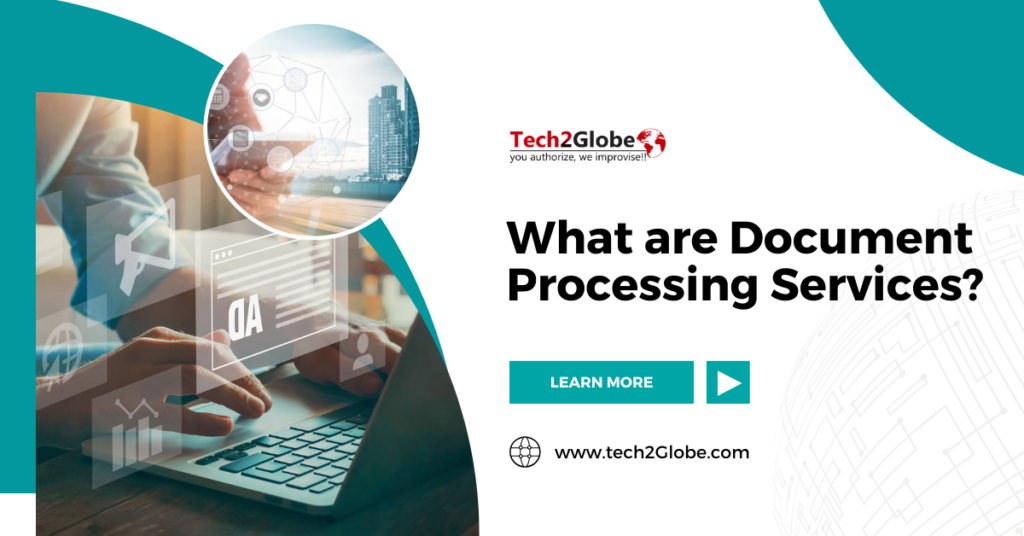It doesn’t matter how great an organization is; most have to deal with many boring document processing jobs. Some of these are typing data for hours on end, reading through emails nonstop, or, even worse, filing thousands of paper documents by hand from old, dusty files. Processing documents manually is not only prone to mistakes but also takes a lot of time and money and is pretty pointless. However, with the assistance of data processing services, these burdensome tasks can be easily handled.
Businesses have begun to look into automating document handling to eliminate this time-consuming and inefficient process. Optical Character Recognition (OCR) and new technologies like Machine Learning (ML), Natural Language Processing (NLP), and other AI technologies are used in automated document processing to improve the process.
Keep reading if you want to know how your company can handle paper processing! You will learn a lot about automatic document handling, how it can be done, and its benefits in this blog.
How Does Document Processing Work?
AI technologies like OCR, NLP, and Computer Vision are used in automated business document processing to turn unorganized data into ordered data. Images, PDFs, printed documents, emails, and other documents are all unstructured data types. On the other hand, structured data comes in the form of CSV, XLSX, XML, JSON, UBL, and other machine-readable formats. Structured data is helpful because it makes it easier for computers and software to work with.
To handle unstructured data, smart software solutions follow the steps below:
Document Structure Categorization and Extraction
Some document processing solutions are built on a specific set of rules. As a result, it is necessary first to develop a set of rules since these lay the groundwork for an accurate data extraction procedure. Document processing software using AI frequently includes the capacity to classify document types. It examines the document and its contents, analyzes the structure type, and discovers common patterns in the file layout.
Information Extraction from Documents
OCR technologies extract information from documents. Optical character recognition converts photos to text, extracts information, and translates it to machine-readable forms like JSON, CSV, and XML. The same may be true for ICR or intelligent character recognition. This technique is beneficial for recognising and extracting handwriting, which cannot be extracted using an OCR solution.
Error Detection and Correction
OCR technologies are sensitive to errors, especially in complex documents with text and images. To avoid surprises, businesses can implement human-in-the-loop processes. With rapid technology development, most OCR software has an accuracy rate of over 90%. With proper training and AI technology support, data extraction output is rarely inaccurate, ensuring a high level of accuracy in OCR software.
File Conversion and Data Storage
The extracted data must be converted into a machine-readable format before further processing. Once the information has been retrieved, it is automatically transformed into JSON format. However, you may convert documents into formats like TXT, CSV, XML, XLSX, and PDF. This allows you to ensure that the information gathered is compatible with any existing application or platform your company may use.
Benefits of Document Processing Services
Accuracy and Efficiency: Processing documents reduces human error in data input and extraction; as with automation, manual interference is minimized, guaranteeing that the data is correct and by rules. It also speeds up document-related tasks, reducing processing times and enhancing overall effectiveness.
Cost Savings: By eliminating manual operations, document process automation helps businesses reduce the labor expenses necessary to do the same activity. Additionally, you must contact advisors from various intelligent document processing firms that will aid you with solutions that are more suited for your organization, saving you money on other document-related expenses.
Scalability: Because these services can manage large amounts of documents, they are suitable for businesses of all sizes. As a company grows, its data and activities expand, so employing a dependable service provider makes sense.
Improved Compliance and Data Insights: Document processing services may help assure adherence to industry-specific norms and standards of conduct. As a result, information will be presented correctly. Once you have the processed documents, you may get valuable insights from the data to make more educated decisions.
Improved Customer Experience: Shorter response times and more precise data processing lead to better customer service. Responding to client inquiries and processing bills promptly will make them feel valued and heard.
Choosing the Right Document Processing Service
You can consider the following factors before you make a decision:
- Knowledge of the company’s specific industry field means they know the document formats and data needs and are able to work with them.
- Stable infrastructure can be built using the latest hardware and software to ensure that the processing is done consistently and with high quality.
- Timely communication and prompt problem-solving, among other things, guarantee a connection free of hassles.
- Precise quality control measures eradicate errors and supply quality information.
- Major security protocols help secure your confidential information.
- Transparency and a fair price ensure a good return on investment.
Having the aforementioned qualities, Tech2Globe has been in the business for the last 14 years, and they know it all. They offer complete document processing service with their experts’ knowledge of advanced technologies. So whether you need data management or Amazon consulting services, just reach out to them. For information and expert guidance, visit their official website at https://www.tech2globe.com or call them at +1-778-382-9628.
Conclusion
The significance of data processing on time is rapidly increasing. The decision of doing it by yourself or looking for proper feedback from experts is your choice. However, with the passage of time, technology is generating more and more data, and hence the document management area is getting more complex.
